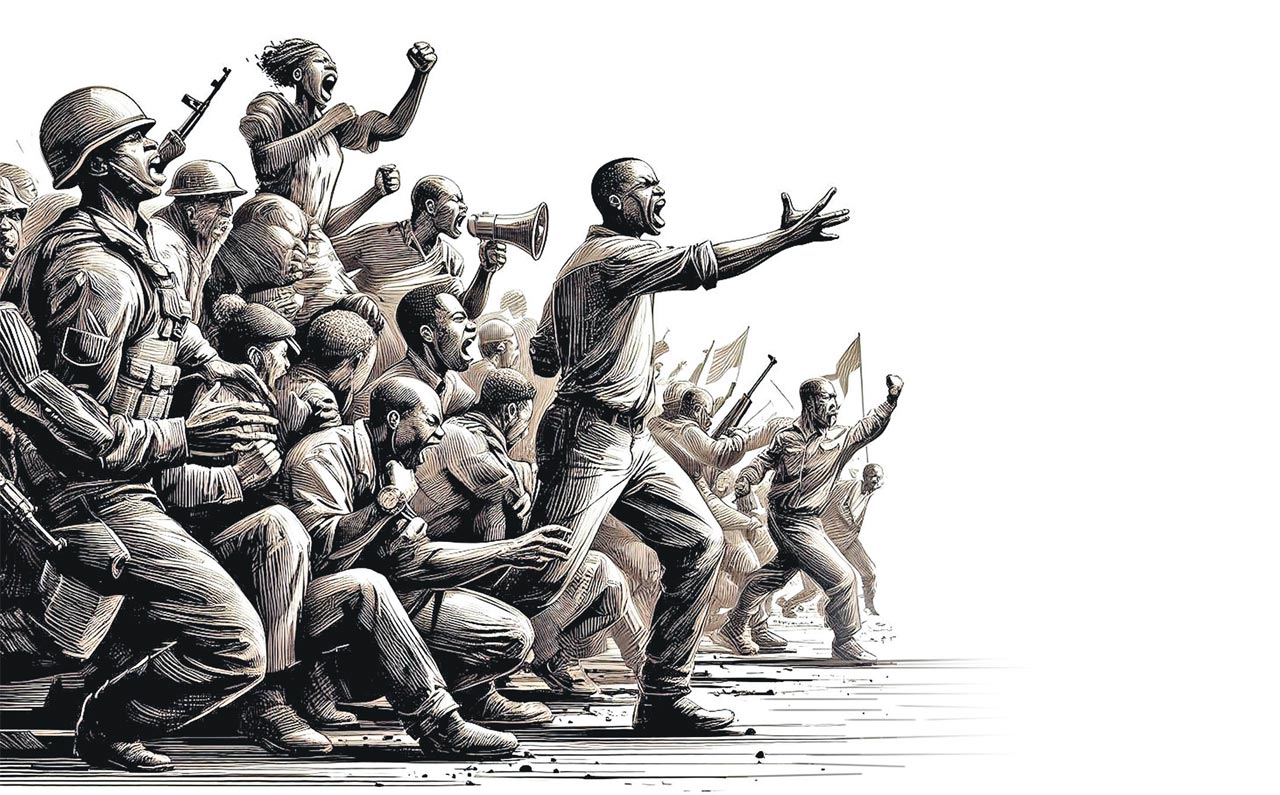It is imperative to remember and commemorate the sufferings so that the hard-won human rights and liberties are preserved, protected and nurtured
Published Date – 12:00 AM, Sun – 29 October 23

By KSS Seshan
Human rights are moral principles, which set certain standards in human behaviour and are protected as legal rights by local, national and international laws. Human rights cannot be transferred, are fundamental rights and egalitarian. Human rights are inherent to all human beings regardless of nationality, residence, gender, ethnicity, colour, religion, region, language or status.
Many of the basic ideas of the Human Rights Movement developed after World War II, which witnessed the great holocaust at Hiroshima and Nagasaki. However, the urge to have individual freedom and liberties is as old as history.
The word ‘Right’ did not exist in any language of the world before the 14th Century AD.
Human rights is a modern concept. It is Euro-centric. The writings of modern political thinkers like John Locke, John Jaques, JS Mill, Thomas Paine, Hegel and others contributed to the idea of Human Rights. During the Renaissance and Reformation movements, painters, artistes, sculptors and even musicians, besides writers and poets, extolled the importance of humanism and the value of individual liberties. On the eve of the French Revolution, several writers championed the cause of human rights.
The Declaration of Independence adopted by the American Congress on 4 July 1776 stated: “All men are created equal, that they are endowed by their creator with certain unalienable rights” that included life, liberty and pursuit of happiness
In fact the word, ‘Right’ did not exist in any language of the world before the 14th Century AD. Rights, Liberties and Freedom were hard won over a period of time, as no government or authority would be willing to surrender its powers to the people on its own. December 10 is celebrated as Human Rights Day as that was the day in 1948 when the UN General Assembly passed the Universal Declaration of Human Rights (UDHR) to preserve, protect and nurture human rights the world over.
Ancient people did not think of universal human rights in the way we do today. In ancient times what people followed was natural rights, and in the Medieval period, it was natural law. But in the Modern period, it was the European Enlightenment that impacted human rights to a large extent.
Rise of Humanism
The dawn of the modern period saw many movements and revolutions, such as the Renaissance and Reformation, which ensured rights and liberties not merely for the nobles and gentry but also for the commoners.
The Renaissance Movement — the revival of ancient Greco-Roman secular tendencies — taught humanistic values and brought a sea change in arts, literature, painting, music, sculpture, architecture and in every form of human faculties. The Italian Renaissance like many other movements of the human spirit was the achievement of a comparatively small minority of gifted and creative men.
The watchwords of the French Revolution were Liberty, Equality and Fraternity, and it declared the ‘Rights of Man and the Citizen’
Dante, the Italian poet, in his Divine Comedy, with humanistic feelings made ‘Man’ as central. He wrote Divine Comedy not in Latin, the divine language, but in the common man’s Italian language. Boccaccio, Petrarch and other Italian writers also wrote with the same spirit of humanism. The Italian example was followed by Geoffrey Chaucer when he wrote The Canterbury Tales, in English. Shakespeare, John Milton, Ben Johnson and others followed in England. In Spain, it was Cervantes who wrote the most popular classic Don Quixote, said to be translated into more languages of the world, next only to the Bible.
Similarly, several artists exhibited their intense secular and humanistic attitudes disregarding religious dogmatism. Michelangelo, Leonardo da Vinci, Raphael, and others, though they painted religious themes, inducted scientific spirit, secular tendencies and humanistic elements in their paintings. ‘Christ’, for example, was painted as an ordinary human being with flesh, blood and bones, bringing humanism to the fore. Sculptors, musicians and all other artistes of the period championed the cause of humanism. Recognising humanist values was fundamental before striving for human rights and liberties.
Reformation and Humanism
Like the Renaissance, the Reformation Movement too was the culmination of the same spirit of humanism. If the Renaissance was a cultural movement to recognise humanism in thought, art and literature, the Reformation pertains to religion. Reformation influenced the people all over Europe more profoundly than the Renaissance.
Martin Luther, the leader of the Protestant Movement, himself, was a champion of humanism. Born in 1483 to a poor peasant-labourer, he opposed practices like Simony, Pluralism and the sale of indulgences as they denied equal opportunities to the common human beings. He attracted the wrath of the Holy Roman Emperor Charles V when he criticised the Roman Catholic Church and wrote 95 theses and pasted them to the Castle Church door at Wittenberg, Germany, in 1519. When he was tried by the emperor at the Diet of Worms, an assembly, he defended himself by proclaiming that the Bible alone was his sole guide.
Martin Luther exhibited his intense humanistic feeling by translating the Bible into the German language. He also wrote a popular book On Monastic Vows. The book had such an electrifying impact that Katharina von Bora, a nun, after reading it became Luther’s follower and married him. Other Protestant leaders like Huldrych Zwingli and John Calvin too were influenced by humanism in furthering Protestantism. As the German sociologist and political economist Max Weber pointed out, the Protestant ethos paved the way for the very growth and development of Capitalism.
The Dutch Declaration of the ‘Rights of Man’ of 1581, an important landmark in human rights, said: “no country on earth should have the authority to control the destinies of the people living in another country”
Individual Rights
However, significant achievement for the cause of human rights was through revolutions, the most important one being the Dutch War of Independence (1568-1648). The Dutch (Netherlands) were ruled by Philip II of Spain and he wanted to make his rule a reality. The Dutch national spirit was thus roused and there was a large-scale uprising. A young adventurer, William of Orange, became their leader who raised a large army charged with the spirit of nationalism and fought against the colonial Spanish army. After two decades of fierce fighting, the Dutch declared their independence in 1581.
The Dutch Declaration of the ‘Rights of Man’ of 1581 is an important landmark in the field of human rights. It said that “no country on earth should have the authority to control the destinies of the people living in another country”. This declaration became an example for many modern revolutions. The Puritan Revolution, The American Revolution and the French Revolution liberally drew inspiration from the Dutch ‘Rights of Man’.
The Bill of Rights
The Bill of Rights, along with the Magna Carta, was the result of the Glorious Revolution of 1688. It is also called the Puritan Revolution or Bloodless Revolution. England during the entire 17th century witnessed a struggle around the question as to where does sovereignty lay? Was it with the king or with the people through Parliament? At the end of the revolution, it was decided with the passing of the Bill of Rights that sovereignty was not with the king but with the people through Parliament.
The Bill of Rights clearly prescribed that the king should at regular intervals convene Parliament and get its consent to levy taxes. It also pointed out that no future ruler of England would be a Roman Catholic. To ensure that only Protestants would ascend the throne, the Bill of Rights prescribed, through an act of succession, the modalities as to who would succeed Mary and William III. Keeping a standing army by the king during peacetime without the permission of Parliament was declared illegal. Protestants were allowed to keep arms for self-defence. The right to petition the king which hitherto was not allowed became legal. Freedom of speech in Parliament was granted. Thus, the journey towards the establishment of the constitutional monarchy, what the United Kingdom is today, began the day when the Bill of Rights came into being in 1689.
The next important milestone in the human rights saga was the Declaration of American Independence in 1766. The entire struggle of the 13 Atlantic seaboard colonies in America that continued for 8 years, 4 months and 15 days (from 1775 to 1783) was for “No taxation without representation”. The British Parliament that taxed Americans had representatives from America. What the Americans wanted was the right to have representation in Parliament. They never said they would not pay taxes, but only if they had representation. The Declaration of Independence was drafted by Thomas Jefferson and the final text was adopted by the American Congress on 4 July 1776. It contained the entire philosophy of human rights inherent to all people, asserting that “All men are created equal, that they are endowed by their creator with certain unalienable Rights” that include life, liberty and the pursuit of happiness.
The French Revolution in 1789 gave great impetus to the cause of human rights. Its very watchwords were: Liberty, Equality and Fraternity. The French Revolution epitomised the struggle for human rights. It declared the ‘Rights of Man and the Citizen.’ It ensured the dignity and honour of the people. Feudalism was abolished. Church lands were confiscated and distributed among the landless commoners. Paper currency was introduced to bring money exchange within the purview of the commoners. Common people were allowed to celebrate functions and festivals from which they were disallowed earlier under the despotic Bourbon rule.
Today if we enjoy human rights in its varied forms, like civil, political, social, economic, and cultural, it is because of the great struggles, movements and revolutions that the people carried over the centuries. These rights and liberties were hard-won. It is imperative to remember, recall and commemorate those struggles and sufferings so that these rights and liberties are preserved, protected and nurtured by the generations to come.
Earliest reference
The earliest reference to human rights is linked to Cyrus the Great, the emperor of Persia, in the 6th Century BC. He issued the edict in 539 BC in the Akkadian cuneiform script, and it was written on a clay tablet in the shape of a burnt cylinder. It was discovered in the ruins of Babylon in Mesopotamia, in the present Iraq, in 1879.
Cyrus opposed the practice of slavery and bondage. The views of the Persian emperor were codified and written in the edict he issued. Reza Pahlavi, the last Shah of Iran, said it was the first-ever document on Human Rights in the world. His sister Princess Ashraf, in October 1971, presented a replica of this famed cylindrical tablet to the then UN Secretary-General, U Thant. The original clay tablet is now preserved in the British Museum and the replica at the UN headquarters, New York.
Magna Carta
A major milestone in the history of human rights is the Magna Carta, or the great charter issued in England. It was the most significant document in the Middle Ages. Issued on 15 June 1215 by King John of England, it contained 63 Clauses and can be divided into 7 or 8 sectors like: Church, Feudalism, Judiciary, Law Justice, London city, Royal Forests and Habeas Corpus. The king was restrained from exercising any control of the Church as the Pope was the supreme authority in matters of religion. The Magna Carta established the Rule of Law in the country. Today, the Magna Carta, along with the Bill of Rights (1689), form part of the unwritten constitution of Great Britain.

(The author is Professor of History [Retired], University of Hyderabad)





